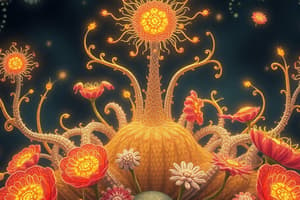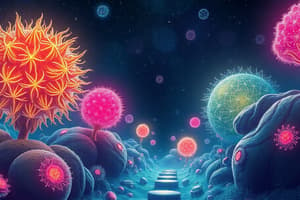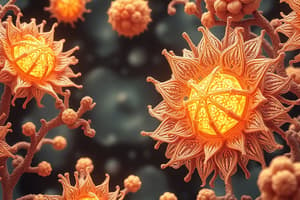Podcast
Questions and Answers
What distinguishes protists from bacteria?
What distinguishes protists from bacteria?
- They are prokaryotic.
- They are autotrophic.
- They have a nucleus. (correct)
- They are unicellular.
Which type of protozoan moves using flagella?
Which type of protozoan moves using flagella?
- Zooflagellates (correct)
- Ciliates
- Sarcodines
- Sporozoans
What is a characteristic of sporozoans?
What is a characteristic of sporozoans?
- They use cilia for movement.
- They are always unicellular.
- They do not move. (correct)
- They are autotrophs.
Which statement about protozoans is true?
Which statement about protozoans is true?
What are the hair-like projections on ciliates called?
What are the hair-like projections on ciliates called?
Which of the following is an example of a sporozoan?
Which of the following is an example of a sporozoan?
What is the movement mechanism of sarcodines?
What is the movement mechanism of sarcodines?
Which term is used to describe an organism that feeds on other organisms?
Which term is used to describe an organism that feeds on other organisms?
Which of these is not a characteristic of protists?
Which of these is not a characteristic of protists?
What type of nutrition method do autotrophic protists utilize?
What type of nutrition method do autotrophic protists utilize?
What characteristic differentiates protists as eukaryotic organisms?
What characteristic differentiates protists as eukaryotic organisms?
Which group of protozoans is recognized for utilizing whip-like extensions for movement?
Which group of protozoans is recognized for utilizing whip-like extensions for movement?
Which of the following best describes sporozoans?
Which of the following best describes sporozoans?
What movement mechanism do sarcodines utilize?
What movement mechanism do sarcodines utilize?
Among the following, which protist is most commonly recognized for causing diseases in humans?
Among the following, which protist is most commonly recognized for causing diseases in humans?
What type of nutrition do heterotrophic protists rely on?
What type of nutrition do heterotrophic protists rely on?
Which characteristic is shared by all protozoans?
Which characteristic is shared by all protozoans?
What distinguishes ciliates from other groups of protozoans?
What distinguishes ciliates from other groups of protozoans?
How do zooflagellates typically assist in their symbiotic relationships?
How do zooflagellates typically assist in their symbiotic relationships?
What is a common feature of all protists in the supergroup classification?
What is a common feature of all protists in the supergroup classification?
Flashcards are hidden until you start studying
Study Notes
Prokaryotes vs. Eukaryotes
- Prokaryotes lack a nucleus and membrane-bound organelles.
- Eukaryotes have a nucleus and membrane-bound organelles.
Protists
- Mostly unicellular
- Eukaryotic
- Divided into four "Supergroups"
- Classified into three categories:
- Heterotrophs (animal-like)
- Autotrophs (plant-like)
- Decomposers (fungus-like)
Protozoa
- Unicellular
- Eukaryotic
- Heterotrophic
- Move
Sarcodines
- Move by extending cytoplasm, called a pseudopod.
- Example: Amoeba
Zooflagellates
- Use flagella for movement.
- Examples: Trichonympha (digests cellulose in termites) and Trypanosoma (causes African Sleeping Sickness)
Ciliaphorans (Ciliates)
- Largest group of protozoans
- Cover their bodies with cilia.
- Example: Paramecium
Sporozoans
- Do not move
- Parasitic protozoans
- Form spores
- Live by parasitizing animals
- Can reproduce sexually and asexually
- Example: Plasmodium (causes malaria)
- Immature sporozoans are called sporozoites
- Transmitted through fluids
Prokaryotes vs Eukaryotes
- Prokaryotes do not have a nucleus or membrane-bound organelles.
- Eukaryotes have a nucleus and membrane-bound organelles.
Protists
- Mostly unicellular organisms
- Eukaryotes
- Not plants nor animals
- Classified into four supergroups
- Can be heterotrophs (animal-like), autotrophs (plant-like), or decomposers (fungus-like).
Protozoans (Animal-like Protists)
- Unicellular
- Eukaryotic
- Heterotrophs
- Can move
Sarcodinians
- Move using cytoplasm extensions called pseudopods.
- Example: Amoeba
Zooflagellates
- Use whip-like extensions called flagella for movement.
- Example: Trichonympha (lives in termite guts and digests cellulose)
- Example: Trypanosoma (lives in tsetse flies and causes African Sleeping Sickness)
Ciliaphorans (Ciliates)
- Largest group of protozoans
- Have tiny hair-like cilia covering their bodies
- Example: Paramecium
Sporozoans
- Parasitic protozoans that do not move
- Form spores
- Live by being parasites on or in animals.
- Can reproduce sexually and asexually
- Example: Plasmodium (causes malaria)
- Immature sporozoans are called sporozoites and can be transmitted through fluids from host to host.
Studying That Suits You
Use AI to generate personalized quizzes and flashcards to suit your learning preferences.




